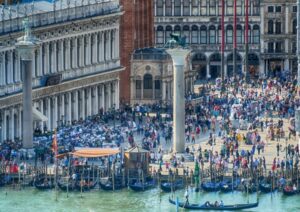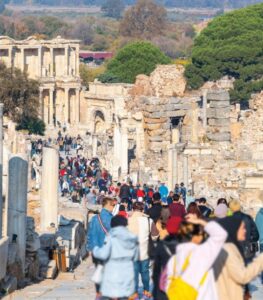
By Serdar Paktin
Founder
Pakt Agency
London, United Kingdom
sp@pakt.agency
Editor’s Note:
Travel and tourism are hot topics right now. Following an article in our fall Industry column on the dynamics of conducting research in the tourism industry, this article explores semiotics and deeper cultural implications around global tourism.
 Like many others, I spent more time in the kitchen during the COVID-19 pandemic, discovering a newfound passion for cooking. What began as a necessity soon transformed into an exploration of Japanese knives. These meticulously crafted instruments opened up a world of precision and artistry for me far beyond their practical purpose, revealing the deeper cultural codes of Japanese culinary tradition.
Like many others, I spent more time in the kitchen during the COVID-19 pandemic, discovering a newfound passion for cooking. What began as a necessity soon transformed into an exploration of Japanese knives. These meticulously crafted instruments opened up a world of precision and artistry for me far beyond their practical purpose, revealing the deeper cultural codes of Japanese culinary tradition.
My fascination with the craftsmanship of these knives led me to learn more about Japan’s culinary culture—its balance, precision, and the artistry that elevates food preparation into something sacred. A trip to Tokyo, especially Kappabashi-dori—a street famed for its endless rows of kitchen equipment stores—now represents more than just shopping for tools. It’s an opportunity to immerse myself in a culture where artistry meets utility and even a knife tells a story.
This passion for precision and artistry aligns with my work as a semiotician. My job is to uncover meaningful connections between tourists and destinations, seeking the hidden cultural threads that create lasting bonds. Think of it like wielding a Japanese knife—precision, artistry, and an eye for the unseen can transform fleeting moments into meaningful, lasting memories—and provide Instagrammable moments simultaneously!

This personal journey reflects the evolving dynamics of global tourism—how travelers’ motivations are shifting and shaped by emerging cultural awareness and needs. As we venture into the world, our expectations intertwine with the local cultural codes we encounter (such as culinary practices, customs, or landmarks embedded with cultural meaning), transforming everyday experiences into something extraordinary. Who knew a street full of kitchen supplies could become
a tourist attraction? Just check Instagram or YouTube.
The Role of the Semiotician and Cultural Strategist
As the world becomes more interconnected, these codes of travel and tourism change rapidly, influenced by travelers’ diverse backgrounds and motivations. This article explores shifts in cultural codes to inspire qualitative researchers to consider how cultural strategy and semiotic research can enhance their approach to tourism research.
- Exploring the new global traveler segments and their unique cultural backgrounds helps us

Crowd of tourists from all over the world at St. Mark’s Square in Venice understand how they interpret local codes (for example, the food they eat, how they interact with locals, or which landmarks they visit).
- Understanding how cultural products, like TV dramas or advertising campaigns, shape travel motivations helps us design culturally sensitive tourism strategies.
- The rise of overtourism (certain places of interest attracting an excessive number of tourists) and its impact on local communities highlight the need for strategies that manage tourist flows and protect cultural authenticity and local resources.
Understanding and navigating cultural codes and meanings is crucial for countries, cities, airlines, cruise companies, travel agencies, destination managers, tourism planners, experience providers, online platforms, hotels, car rentals, etc., who want to attract, engage, and provide meaningful experiences to diverse travelers by aligning their offerings with the cultural expectations and values of their visitors but also foster sustainable and culturally respectful tourism.
Consider the tension in cities like Barcelona and Venice, where the influx of tourists has led to friction between local needs and visitors’ desires. Or, take the case of Fujikawaguchiko in Japan, where locals had to install fences to manage crowds of tourists eager to photograph Mount Fuji, only for the barriers to be bypassed. These examples highlight how our expectations and the cultural context of a place can lead to clashes. But, as with the Japanese knives, there is always an opportunity to reveal deeper layers of meaning that we can then use to turn these tensions into meaningful engagement.
Emerging Cultural Trends in Global Tourism
- The Rise of New Traveler Segments
As global travel becomes more accessible, economies like China, India, and Southeast Asia send out new waves of travelers, bringing distinct cultural values, expectations, and aspirations. For instance, travelers from China often seek luxury goods and prestigious experiences, while Indian tourists may pursue spiritual enrichment or culturally significant sites. These motivations differ significantly from those of traditional Western tourists.

For instance, Santorini Island in Greece is a famous honeymoon destination, Brugge in Belgium is for experiencing the European Middle Ages, and the Spanish island of Ibiza is for clubbing! These places have preconceived associations with Western tourists through long years of established norms. Cross-cultural understanding becomes essential in reinterpreting these destinations. For qualitative researchers, this requires reconceptualizing a place as many places—one seen through the eyes of travelers from different cultural backgrounds.
Take Paris, which symbolizes romance and history for many Western tourists. For Chinese tourists, it may need to be reimagined as a high-end shopping destination, while for Indian tourists, it could be positioned as a hub for cultural exploration. Understanding the unique values and semiotic codes of these new traveler segments is critical to crafting marketing strategies that resonate with their expectations. These examples are, of course, stereotypical and shallow—I use them to make a point.
- The Influence of the Creative and Cultural Economy
The creative and cultural economy has become a significant driver of global tourism trends.
As tourism is bouncing back to pre-pandemic levels, specific destinations have started to experience the challenges of overtourism and local inhabitants’ disturbances. Creative products—such as literature, music, cinema, or television—are not just forms of entertainment; they are catalysts for travel, influencing where people want to go and what they wish to experience.
In the past, the U.S. and the U.K. had the most influence on global creative and cultural production. However, other countries and cultures have emerged as primary producers and cultural influencers over the last decade. For instance, Turkey has become the third-largest TV exporter after the U.S. and U.K., attracting over a billion viewers annually. Similarly, South Korea has become a major cultural influencer with its Hallyu trend (a Chinese term which, when translated, literally means “Korean Wave”), which includes TV series, K-Pop, and other creative and cultural output.
One striking example is South Korea’s impact on global tourism through its television dramas, often called the “Netflix effect.” Research shows that South Korean dramas, like Crash Landing on You, have shaped the travel decisions of young Western women, particularly in their portrayal of romantic and emotionally attuned men. This has increased the number of female tourists visiting South Korea, drawn by the desire to experience the dating and love culture depicted in these dramas.
However, the reality on the ground is beyond the symbolic representation of the TV series, frequently ending with a disappointing experience for those emotionally invested tourists. There is a cultural gap between the representation and the actual experience, hence the need for research to dig deeper and uncover how that could be utilized to improve tourism.
Similarly, Turkey has emerged as a player in the global creative economy, mainly through its various television series. Turkish dramas, famous across Latin America, the Middle East, South Asia, and beyond, showcase the country’s cultural heritage and have sparked a surge of interest in visiting Turkey. Research by the Yunus Emre Institute found that many international viewers began learning Turkish after watching these shows. This highlights how creative products can foster deeper cultural connections, drawing travelers to experience the settings they have seen on screen.
For qualitative researchers, it is vital to consider these examples to embrace a more holistic approach to their research by investigating creative, cultural, and popular touchpoints. This can include incorporating semiotics into the research process to help explain how symbols, narratives, and cultural codes in media influence perceptions of destinations, sparking travel desires and shaping tourists’ decisions.
- Overtourism and Its Consequences
The rise of global travel has brought challenges, most notably overtourism. Popular destinations like Spain’s Mallorca and Italy’s Venice have struggled with the overwhelming number of tourists, leading to the deterioration of local services and cultural environments. In Mallorca, protests have erupted as locals express frustration over the disappearance of local culture, rising living costs, and the strain on public services. The “Occupy Our Beaches” movement symbolizes the growing tension between residents and visitors as locals reclaim public spaces.
 In the summer of 2023, Greece witnessed the “towel movement,” where locals reclaimed beaches from commercial establishments, asserting their right to free and public beach access. This prompted the government to enforce stricter beach regulations through frequent inspections.
In the summer of 2023, Greece witnessed the “towel movement,” where locals reclaimed beaches from commercial establishments, asserting their right to free and public beach access. This prompted the government to enforce stricter beach regulations through frequent inspections.
Overtourism strains local resources and can erode the cultural authenticity that travelers seek. When destinations are marketed and managed without regard for their cultural and environmental limits, the result is often cultural erosion. For instance, the daily lives of locals become more difficult socially, economically, and logistically. Rental prices skyrocket, and locals buy more expensive food and ingredients, rapidly changing their perception of tourism and tourists.
Tourism research plays a crucial role in bringing both perspectives into consideration and helping devise more meaningful, culturally attuned travel experiences while preserving local integrity. To achieve this, it is essential to explore the emerging strategies used to address overtourism in different locations worldwide.
Efforts to Tackle Overtourism
In response to overtourism, innovative strategies have been introduced in various destinations. For

example, Copenhagen has implemented the “CopenPay” initiative, using dynamic pricing to manage tourist flows and incentivize visits during off-peak times while encouraging green choices. CopenPay makes a semiotic attempt to transform visitors’ considerate behavior into economic value and initiatives. It becomes an excellent example of exploring a mutually beneficial common ground for visitors and locals to use the city.
In Japan, admission prices and accommodation taxes have been raised in popular spots like Kyoto and Tokyo to reduce overcrowding and fund preservation efforts. Venice has introduced a day tripper fee to discourage short, high-impact visits and encourage more extended stays that contribute more meaningfully to the local economy. These examples create a symbolic representation resembling paying a tax or fine for doing something wrong and being punished for it, which semiotically could instill a negative meaning after a while, creating more harm in the long run.
The two strategies mentioned above demonstrate solid dedication to promoting sustainable tourism. However, their approach and cultural coding differ significantly from each other (e.g., incentivize visits during off-peak time versus penalize short high-impact visits). Decoding the underlying cultural symbols, narratives, and values through semiotics helps better understand how, for example, policies, pricing, and messaging impact perceptions, allowing for more nuanced approaches that foster mutual respect and balance between visitors and residents.
 Strategic Implications for the Future of Global Tourism
Strategic Implications for the Future of Global Tourism
Semiotics and cultural strategy offer valuable insights for researchers to contribute to these strategic shifts.
Communication Shapes Visitor Behavior: How destinations are marketed and communicated through semiotic codes and meanings can significantly influence tourist behavior. For example, emphasizing party culture can lead to reckless behavior among tourists, which recently caused problems in Spain’s Ibiza and Magaluf. On the other hand, promoting responsible tourism can attract visitors who engage respectfully with local cultures. An example is Norway’s “Visit Oslo” campaign, which targeted ethical and considerate travelers seeking authentic experiences.
Adapting Marketing Strategies: Tourism marketers must rethink how they communicate with and attract travelers from diverse cultural backgrounds. Marketing that resonates with Western audiences may not work for tourists from Asia or the Middle East. More culturally nuanced approaches are required to connect with the unique aspirations of these new traveler segments.
Rethinking Destination Management: As overtourism becomes more significant, destinations must adopt more sustainable and culturally relevant practices. This includes investing in infrastructure that supports increased tourism while preserving the local culture and environment. Also, measures to prevent overtourism should positively impact locals and visitors rather than feeling punitive or intimidating.
Emphasizing Cultural Sensitivity and Ethical Tourism: As tourism becomes more globalized, the industry must navigate the delicate balance between attracting visitors and respecting the cultural integrity of destinations. Ethical tourism practices that emphasize cultural sensitivity, responsible behavior, and community engagement are increasingly recognized as essential to sustainable tourism.
Preparing for Future Challenges and Opportunities: The future of global tourism will be shaped by how well the industry adapts to travelers’ changing demands and destinations’ evolving landscapes. This requires a deep understanding of current trends and the ability to anticipate and respond to future challenges, such as geopolitical shifts, environmental changes, and technological advancements.
Conclusion: A New Era of Tourism Through Semiotics
The future of global tourism depends on evolving with travelers’ shifting motivations. Semiotic analysis offers a way to decode the cultural codes that shape how we experience destinations. Qualitative research can help tourism professionals craft deeper, more meaningful experiences by harnessing these insights.
As travelers become more conscious of their impact on communities, the industry must embrace ethical tourism as a standard, preserving cultural and environmental integrity. By aligning tourism with deeper cultural understanding and sustainability, we can create enriching, responsible travel experiences that connect culture with curiosity—and deliver perfect Instagrammable moments.




